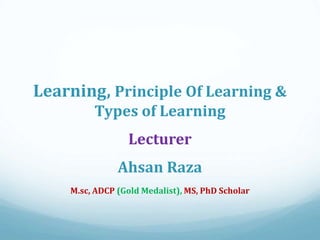psychology_chapter_5_learning_and_its_principles.ppt
•Download as PPT, PDF•
0 likes•4 views
This document defines learning and discusses various types and principles of learning. It defines learning as a relatively permanent change in behavior resulting from experience. The types of learning discussed are motor, verbal, concept, and attitude learning. The principles of learning explained are operant conditioning established by Skinner, and classical conditioning established by Pavlov involving conditioning a response to a neutral stimulus. Examples are given of using operant and classical conditioning in clinical settings. Learning theories discussed include behavioral, cognitive, social, and humanistic approaches.
Report
Share
Report
Share

Recommended
More Related Content
Similar to psychology_chapter_5_learning_and_its_principles.ppt
Similar to psychology_chapter_5_learning_and_its_principles.ppt (20)
Chapter 4 introduction to learning theory and behavioral psychology 

Chapter 4 introduction to learning theory and behavioral psychology
Running head DISCIPLINE-BASED LITERATURE REVIEW 1Discipli.docx

Running head DISCIPLINE-BASED LITERATURE REVIEW 1Discipli.docx
learning_theories_(skinner_operant_conditioning)[1].ppt![learning_theories_(skinner_operant_conditioning)[1].ppt](data:image/gif;base64,R0lGODlhAQABAIAAAAAAAP///yH5BAEAAAAALAAAAAABAAEAAAIBRAA7)
![learning_theories_(skinner_operant_conditioning)[1].ppt](data:image/gif;base64,R0lGODlhAQABAIAAAAAAAP///yH5BAEAAAAALAAAAAABAAEAAAIBRAA7)
learning_theories_(skinner_operant_conditioning)[1].ppt
Recently uploaded
The Author of this document is
Dr. Abdulfatah A. SalemOperations Management - Book1.p - Dr. Abdulfatah A. Salem

Operations Management - Book1.p - Dr. Abdulfatah A. SalemArab Academy for Science, Technology and Maritime Transport
Recently uploaded (20)
Industrial Training Report- AKTU Industrial Training Report

Industrial Training Report- AKTU Industrial Training Report
UNIT – IV_PCI Complaints: Complaints and evaluation of complaints, Handling o...

UNIT – IV_PCI Complaints: Complaints and evaluation of complaints, Handling o...
Operations Management - Book1.p - Dr. Abdulfatah A. Salem

Operations Management - Book1.p - Dr. Abdulfatah A. Salem
Benefits and Challenges of Using Open Educational Resources

Benefits and Challenges of Using Open Educational Resources
Salient features of Environment protection Act 1986.pptx

Salient features of Environment protection Act 1986.pptx
MARUTI SUZUKI- A Successful Joint Venture in India.pptx

MARUTI SUZUKI- A Successful Joint Venture in India.pptx
Danh sách HSG Bộ môn cấp trường - Cấp THPT.pdf

Danh sách HSG Bộ môn cấp trường - Cấp THPT.pdf
aaaaaaaaaaaaaaaaaaaaaaaaaaaaaaaaaaaaaaaaaaaaaaaaaaaaaaa

aaaaaaaaaaaaaaaaaaaaaaaaaaaaaaaaaaaaaaaaaaaaaaaaaaaaaaa
Basic Civil Engineering Notes of Chapter-6, Topic- Ecosystem, Biodiversity G...

Basic Civil Engineering Notes of Chapter-6, Topic- Ecosystem, Biodiversity G...
Adversarial Attention Modeling for Multi-dimensional Emotion Regression.pdf

Adversarial Attention Modeling for Multi-dimensional Emotion Regression.pdf
Forest and Wildlife Resources Class 10 Free Study Material PDF

Forest and Wildlife Resources Class 10 Free Study Material PDF
psychology_chapter_5_learning_and_its_principles.ppt
- 1. Learning, Principle Of Learning & Types of Learning Lecturer Ahsan Raza M.sc, ADCP (Gold Medalist), MS, PhD Scholar
- 2. DEFINITION OF LEARNING Gardner Murphy (1968) - the term learning covers every modification in behavior to meet environmental requirements. Gates (1946) – learning is the modification of behavior through experience. Most psychologist defines as relatively permanent change in behavior that results from experience. Woodworth (1945) – any activity can be called learning so far as it develops the individual (in any respect, good or bad) and makes his later behavior and experiences different from what they would otherwise have been.
- 3. Types of Learning Motor Learning: Most of our activities in our day-to-days life refer to motor activities. (E.g. walking, running, skating, driving, climbing). Verbal learning: This type of learning involves the language we speak, the communication devices we use. (Signs, pictures, symbols, words) Concept learning: It is the form of learning which requires higher order mental processes like thinking, reasoning, intelligence, etc. (For example, when we see a dog) Attitude learning: Attitude is a predisposition which determines and directs our behavior. We develop different attitudes from our childhood about the people, objects and everything we know. Learning of principles: Individuals learn certain principles related to science, mathematics, grammar, etc.
- 4. Principles of Learning A. Operant Conditioning learning new behaviors or changes in behavior occur on the basis of the environmental conditions or responses to it. Operant conditioning was established by the work of BF Skinner. Operant conditioning occurs when a behavior that is not a part of persons natural responses is learned (or unlearned) by consequences in the form of reward and punishment The famous Skinner Box demonstrated operant conditioning
- 9. Shaping Shaping involves rewarding closer and closer approx. of the wanted behavior until the correct behavior is achieved. An example of this is when a child learning to write Modeling Modelling is a type of observational learning. This is what occurs when a student starts to talk, dress and behave in a manner similar to that of an inspiring teacher;
- 10. b. Classical Conditioning It involves three factors: A neutral stimulus (Whistle), a stimulus (Food) that causes a biological response, and the biological response (Salivation) itself. It is a form of learning that occurs when these two stimuli are paired. Neutral Stimulus = Conditioned Stimulus (bell, whistle, smell) Stimulus = Unconditioned Stimulus (Food, room temp.) Biological Response = Unconditioned Response (Salivation) When a biological response is coupled with a neutral stimulus that would not normally cause it, such as a bell causing salivation, this is known as a conditioned response.
- 14. Use of Operant Conditioning against bad habit (Clinical Setting) 1. Try to discover what is reinforcing a bad habit, and remove, avoid or delay the reinforcement 2. Avoid or narrow down cues that elicit the bad habit (e.g. by removing ashtrays, matches and extra cigarettes from his house, car and office.) 3. Make an incompatible response in the presence of stimuli that usually precede the bad habit (e.g. putting her hands in her pockets, taking notes in her class, sketching pictures, crossing her arms, chewing gum 4. Use negative practice to associate a bad habit with discomfort. 5. Utilize feedback to change bad habits.
- 15. Uses of Classical Conditioning in Clinical Setting 1. Acquisition of fear and anxiety about hospitals (e.g. associate (pair”) neutral stimuli such as white coats with nasty, painful events (injections, drips) 2. Chemotherapy for treating cancer (e.g. f powerful cytotoxic drugs that have marked side effects. The patient’s hair falls out, they feel nauseous and sick, and are unable to eat) 3. Treatment of Phobias (A form of therapy known as Systematic Desensitization based on classical conditioning can be beneficial in treating patients)
- 23. Learning Theories Behavioral Cognitive Social Humanistic